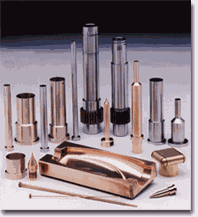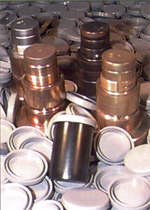
|

...World Wide Distributor of Beryllium-Free Copper Alloys...
Manufacturer of Standard & Custom Components
![]()
Site Updated Often! To ensure proper viewing please Refresh page &
MAKE SURE YOUR BROWSER IS SET TO UPDATE AT EACH VISIT
![]()
|
||||||||||
| Kodak cools cartridge cover with copper alloy cores | ||||||||||
Every year Eastman Kodak Co. molds hundreds of millions of 35-mm film canister covers, gray LDPE lids well known to photographers. But a few years ago these covers were the cause of headaches. Chronically hot cores were causing pulled centers where the part failed to eject.
|
|
|||||||||
| The steel used for the cores was a 420
stainless. Kodak thought it could run cooler and faster with a copper alloy core, but
before making the investment, decided to do some testing on the hypothesis. The copper alloy Kodak tested is C18000, which according to specs, is nine times more conductive than 420 stainless steel. However, C18000 is also softer, with a hardness of 92 to 94 Rockwell B, vs. 48 to 52 Rockwell C for the stainless steel. Because of this, Kodak decided also to test three surface treatments to protect the cores from gassing and plastic abrasion. Most 35-mm cover molds run for a year or more before preventive maintenance is performed. |
||||||||||
Figure 1: Kodak's Lebeau and Glozer first assessed the thermal conductivity of the stainless steel, copper alloy, and the LDPE cover part. The results from this steady state test show that the cover generated heat at a faster rate than the stainless could remove it. The copper alloy's thermal conductivity should be able to cool the 35-mm cover faster. |
Thermal
Conductivity The project was headed up by senior technical personnel Gary Glozer and Brett Lebeau, who work at Kodak's Enterprise process and Tooling Development Lab in Rochester,. NY. They started by assessing the conductivity of the stainless steel and copper alloy. Using some relatively simple math, Glozer and Lebeau calculated the thermal conductivity of the steel and alloy, as well as the LDPE material used in the part itself. What they discovered was that the heat transfer value of the LDPE cover was greater than the heat transfer value of the stainless steel mold core (Figure 1). This meant that the current 420 stainless steel core could not take heat away as fast as the plastic gave it up. On the other hand, the copper alloy showed its potential by removing heat one and a half times faster than the; plastic gave it up. |
|||||||||
The
Single Cavity Test |
||||||||||
| The 48-Cavity Test As mentioned earlier, the C18000 copper alloy is significantly "softer" than, the 480 stainless steel. As part of the 48-cavity production trial, Glozer and Lebeau also tested three different surface enhancements on the copper ally cores, chrome, titanium nitride and boron carbide (carbon black). Of the 48 copper alloy cores, three sets of 12 were treated with each coating. The fourth set of 12 was left untreated as a control. The cores were distributed evenly though out both halves of the stack mold to test the effect of core location on each surface treatment. |
|
|||||||||
| To start the test, Glozer and Lebeau collected temperature data on the stainless steel cores. Their results show the stainless steel produced parts on 10.7-second cycles with an average part temperature of 110F. The mold was then removed from the machine --a 220-ton Husky-- and the copper alloy cores were installed. The mold was reinstalled and run at the same process conditions. for the same 10.7-second cycle, average part temperature from the copper alloy cores was 83F. | ||||||||||
| Encouraged by such results, Glozer and Lebeau started reducing the cooling time on the process in .5-second intervals. The most that could be taken off was 2.7 seconds, which allowed for the fastest cycle of 8 seconds. This was dictated by the amount of time required for screw recovery. As cycle time decreases, part ejection temperatures increased. | ||||||||||
Even at the fastest cycle of 8 seconds, the copper alloy cores produced parts that were cooler than those from the 420 stainless steel cores. |
||||||||||
| However, even
at the fastest cycle of 8 seconds, the copper alloy cores produced parts that were cooler
than those from the 420 stainless steel cores. For production, Glozer and Lebeau
settled on a midrange cycle time, which they calculated would provide substantial savings
and eliminate the pulled core problem. This midrange cycle time also would most
likely provide the greatest margin of processing error. Coating of Choice The mold was in production for more than 30 weeks, ran 1.12 million cycles, and produced more than 53 million parts, none of which was returned for pulled centers. Then the durability of the surface treatment was assessed. As expected, the uncoated copper alloy cores showed a visible change in appearance of the vapor-honed surface texture in the area directly across from the gate. There was little coating left on the cores protected with the boron carbide. It appeared the coating did not effectively adhere to the copper alloy substrate and eventually wore off. Texture changes were similar to those of the uncoated ones, but less severe. At $88 per core, the boron carbide was also the most expensive coating. The chrome-coated cores showed a slight visible change in appearance but there were no signs of adhesion problems. The chrome was the least expensive at $8 per core. The titanium nitrided cores revealed no visual change in appearance and outperformed even the chrome. At $26 per core, the titanium nitride was deemed the best performer for the money and chosen for production. |
||||||||||
| Kodak solved its sticking problem in the mold for film cartridge caps by replacing a 120 stainless steel core with one of a TiN-coated copper alloy and reduced cycle time as well. | ||||||||||
| The Bottom
Line In the end, Kodak not only reduced average part ejection temperature and eliminated pulled centers, but decreased the cycle time as well. The 16 percent savings in cycle time and temperature allowed Kodak to produce 366,100 more 35-mm covers each week with a more durable and reliable core material.--Jeff Sloan Injection Molding Magazine Reprinted with permission |
||||||||||
|
|
||||||||||
|
||||||||||
|
Copyright © 2024 by Performance Alloys &
Services, Inc |
||||||||||

